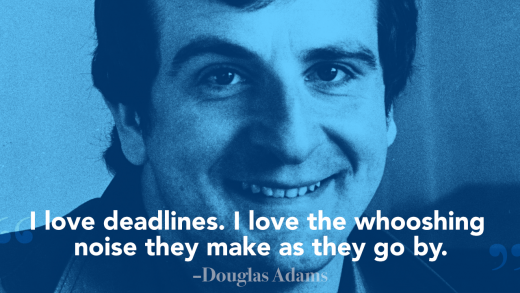
Brian Honigman is a content marketing consultant and the CEO of Honigman Media. For more insights on how to be a better marketer, sign up for his weekly newsletter. This post originally appeared on his blog.
For those in the marketing industry, there’s very little doubt. Content marketing works.
While there’s no debating that content marketing works, it only works if it’s done right; and one of the keys to doing content marketing right is to do it consistently.
Woody Allen famously quipped that “80 percent of success is just showing up.” For content marketing this is certainly true.
Most content marketing efforts don’t fail for lack of quality or quantity – they fail for lack of consistency.
However, keeping up the kind of sustained effort necessary to achieve content marketing success is very difficult. Luckily, there are some simple tactics and strategies that you can follow to help ease the pain of the content marketing grind.
Whether you’re a one person-team or you run a content division, these tips will help you build a sustained content marketing rhythm.
Find Your Ideal Rhythm
Certainly any good content strategy requires some type of regularity to be effective, but depending on the type of content you produce, where you release it, and how in-depth it is, this schedule will look very different.
However, there are certain baseline rhythms that typically represent a good starting point to work from. These baselines are commonly remembered and referred to using the acronym of the “1-7-30-4-2-1 Rule.”
These numbers refer to the intervals at which different types of content should be released. For example, social postings should typically be put out at least once a day, blog posts once a week… etc.
While these guidelines might be useful starting points, they are still just averages. The first step to determining the rhythm that works best for your content is to understand your audience expectations and the type of content that you are aiming to create. James Hill, the Chief Strategy Officer of the agency McMurry/TMG put it very well in the following quote:
“It all boils down to what motivates your audience to seek out content (and how often) and how to meet those needs.”
Once you have determined which content-type and social channels are right for you, try and test a rhythm. In my last post I laid out a method for measuring and testing an ideal volume for Facebook posts (see section three).
This method of building up posts and seeing when engagement peaks can truly work for any kind of content-type or channel.
Essentially, what you should do when finding your ideal rhythm is to start at your minimum viable point and work up the pace until your returns start to decrease or the increase in engagement is marginal.
If you build up your rhythm steadily, you’ll reach a good clip whose upper limit will either be determined by your raw ability to push out content and maintain quality or (the much rarer problem) of putting out material too frequently.
Build a Buffer Zone
Using the method outlined above, you should arrive at a healthy and achievable target rhythm for your content. After all, the ideal rhythm is one that is engaging but that, above all, is sustainable.
Although this ideal rhythm will be very much within your reach most of the time, and will only get easier as you get into the habit of maintaining it, there may be some wobbles in the cycle where a key team-member is out or you simply got writer’s block.
If you don’t account for these gaps you can lose your beat, which, is one of the most important elements in content marketing. Luckily, there are a few simple strategies for catching yourself when you stumble.
The most important of these strategies is setting up a comfortable “buffer-zone.” Even if you feel supremely confident in your ability to maintain your rhythm (in which case, I envy you), you should never be living “paycheck-to-paycheck” with your content, so to speak.
As the author of The Hitchhiker’s Guide to the Galaxy, Douglas Adams once put it very well “I love deadlines. I love the whooshing noise they make as they go by.”
Creating an effective buffer-zone is simple in theory, and a little more difficult in practice. The idea is to create enough content to allow you (and/or your team) a two-week window in which you could not create any new content and still keep on rhythm.
Since you don’t know when you’ll have to fall back on this content it should be evergreen and close enough to the finished stage to be ready to post at a moment’s notice.
Given that this will likely constitute roughly two-weeks worth of allotted “content-time,” you might be asking the inevitable question “how can my team and I possibly hope to create all this extra content and still stay on pace?”
Create a “Piggy Bank” for Developing Content Ideas
By definition, once you set a rhythm as a target you will constantly be stemming the tide of work coming in. It can be so difficult to simply keep up with the pace you’ve set for yourself, that the notion that you should also create content to keep ahead.
However, the difficulty of keeping up with content in the first place should provide the perfect incentive to plan for the worst. There is going to be a week or two in the next quarter where you come up short on a deadline. I hate to be pessimistic, but that’s just the way it works.
The best way to avoid this “paycheck-to-paycheck” mode of existence is to set up a saving’s account of ideas. These are broad ideas for evergreen content (exactly the kind of content you want for your buffer zone) that you keep in an accessible place like a Google Doc or Excel spreadsheet so that you can constantly contribute to them over time.
Think of this almost like a “content piggy bank” where you can keep ideas for content and just drop a small insight, link or example in every now and then. Broad research is almost always part of content-creation, and oftentimes you run across valuable nuggets of wisdom that don’t directly apply to what you’re working on.
Much like real-life piggy banks, what will happen over the course of a couple months is that all of these “loose change” ideas will accumulate and when a disruption forces you to crack the bank open and be absolutely shocked by how much valuable content is in there.
Embracing this method and letting posts grow organically in the background of your day-to-day is an easy way to have a constantly refreshing store of buffer-zone posts. In addition, this ensures that no good ideas or insights generated by you and your team go to waste.
Intensify your Existing Rhythm During Peak Periods
Going back to the beginning of this post, remember that consistency is the aim of content marketing because your aim is to have content match your audience’s expectations.
For the most part, this rule holds true, because most of the times your audience’s expectations stay relatively constant. However, for many businesses, brands and industries there are a few times of the year where the audience expectations change fairly dramatically.
In order to keep your content rhythm in line with your audience expectations during these peak times it might be necessary to seriously ramp up your existing rhythm in short bursts.
This trend tends to become really recognizable around big-ticket events like the Super Bowl or the Oscars. However, these tend to not be the best times to ramp up your content efforts unless the event really relates to your industry. The more crowded the event, the more noise you’ll have to compete with.
Ramping up your content efforts is very resource intensive, and it would be a complete waste of time and energy if those increased efforts didn’t resonate with your audience.
Instead of just following the pack to the Oscars or Super Bowl, think long and hard about your industry and audience and identify your own individualized “big events.”
For example, within the content marketing universe there are quite a few high profile conferences. The Content Marketing World conference might not mean very much to very many people other than the marketing community, but to your audience this event might mean much more than the Super Bowl. I know it does for me (I’m a nerdy marketer, don’t judge me).
At the beginning of every cycle, sit down with your team and map out any major events within your industry. Incorporate these events into your editorial calendar and plan to allocate more resources towards ramping up your content rhythm during these crucial periods.
One common thread you may be noticing running through all of this advice is that keeping pace with your content requires lots of forethought. Most people think of rhythm as something you achieve by being in the moment, but for content the opposite is true.
Keeping consistency throughout your work requires coordination, forethought and lots of planning. As Deirdre Breakenridge, CEO of Pure Performance Communications and Adjunct Professor at NYU advises potential content creators:
“Before you [even start to] think specific content and distribution, get your content engine into place. Evaluate your internal resources and set up a workflow with your team… Having the people, process and technology in place first will really help you to maintain a long term content effort.”
In other words, in order to be guaranteed a consistent content rhythm, you and your team really need to plan ahead effectively. Content marketing is not something you figure out and maintain on the fly, it is something you actively prepare for well in advance.
Sure there will be hiccups and changes along the way, but adequate preparation will make sure that you keep your rhythm and never miss a beat.
Read Next: The results driven approach to blogging
Image credit: Shutterstock, Brianhonigman.com
Get the TNW newsletter
Get the most important tech news in your inbox each week.










